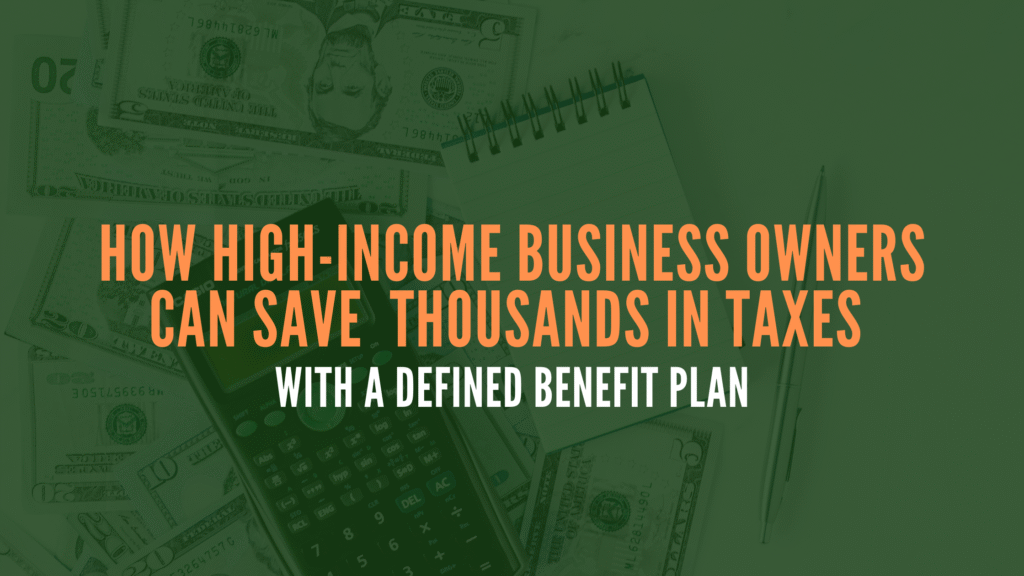If you’re a self-employed professional or small business owner earning a high, consistent income, you’ve likely maxed out traditional retirement options like a SEP IRA or Solo 401(k). But what if you could contribute far more while dramatically cutting your current tax bill?
Enter the Defined Benefit Plan, a lesser-known but incredibly powerful retirement and tax planning strategy designed for high earners.
Although these plans are often associated with large corporations or public-sector pensions, they can be just as valuable for independent professionals, consultants, and solo entrepreneurs particularly those in their 50s or 60s who want to accelerate savings before retirement.
What Is a Defined Benefit Plan?
A Defined Benefit Plan (DBP) is a type of retirement plan that promises a specific benefit amount upon retirement typically based on factors like your salary, years of service, and age.
Unlike a defined contribution plan (such as a 401(k) or SEP IRA), where you contribute a fixed amount each year, a defined benefit plan calculates your contributions based on how much income you want to receive in retirement.
That means the older you are and the closer you are to retirement, the larger your contributions can be sometimes several times higher than what’s allowed in a 401(k).
Why High-Income Solo Business Owners Love It
For self-employed individuals earning six or seven figures, the defined benefit plan is often the only legal way to shelter hundreds of thousands of dollars from taxes while funding retirement at an accelerated pace.
Here’s who it’s best suited for:
- You’re 50 or older
- You earn consistent, high income each year
- You’re comfortable committing to contributions for several years
- You want to contribute more than $70,000 annually
Let’s put this into perspective:
Someone earning $1 million per year could potentially contribute around $300,000 annually to their defined benefit plan, all tax-deductible. That could mean over $100,000 in annual tax savings while building a multi-million-dollar retirement fund.
How It Works
Because defined benefit plans are actuarially based, your annual contribution isn’t arbitrary it’s calculated by an actuary using a formula that considers:
- Your current age
- Your income level
- Your target retirement age
- Your desired retirement benefit
For 2025, the IRS allows the following limits:
- Up to $280,000 per year in retirement benefits
- Up to $3.5 million in total plan accumulation
- Contributions based on compensation up to $350,000
These numbers make the defined benefit plan one of the most generous tax-deferral vehicles currently available to self-employed professionals.
Tax Benefits of a Defined Benefit Plan
The primary advantage is massive tax savings both now and in the future.
Here’s how it helps:
- Immediate Tax Deductions
Your contributions are fully tax-deductible as a business expense, reducing your taxable income in the year you contribute.
- Tax-Deferred Growth
The funds inside your plan grow tax-deferred until you begin withdrawals in retirement.
- Potentially Lower Future Tax Rates
If your income drops after you retire, you’ll likely pay lower tax rates on distributions than you would today.
- Enhanced Retirement Security
Because contribution limits are so high, you can build a multi-million-dollar nest egg much faster than with other plans.
While the defined benefit plan offers remarkable benefits, it’s not for everyone. It comes with complexity and a few strings attached.
Here are the key things to keep in mind:
- Setup and Maintenance Costs
Expect to pay around $1,000 to $4,000 per year for administration, actuarial calculations, and IRS filings. This is higher than the cost of a SEP IRA or Solo 401(k), but often negligible compared to the tax savings.
- Commitment Required
Because this is a pension-style plan, you’ll need to make contributions annually for several years. It’s best suited for those with predictable, high income.
- Limited Flexibility
Funds are generally locked until retirement age. Early withdrawals may trigger taxes and penalties, similar to other retirement accounts.
- Integration with Other Plans
You can combine a defined benefit plan with a 401(k) profit-sharing plan for even greater tax advantages but it requires careful coordination with a qualified advisor.
Let’s say you’re a 55-year-old consultant who runs a successful S corporation and earns $750,000 annually.
You’ve already maxed out your Solo 401(k) contributions ($69,000 for 2025), but you still have excess income that’s heavily taxed.
By setting up a Defined Benefit Plan, an actuary determines that you can contribute $220,000 per year all tax-deductible.
If you’re in a 45% combined federal and state tax bracket, that single move could save you nearly $100,000 in taxes in the first year alone while building long-term retirement wealth.
A defined benefit plan makes the most sense if you:
- Want to retire within 5–15 years
- Have predictable cash flow from your business
- Already maxed out other retirement vehicles.
- Are looking for substantial tax savings in your peak earning years
For many high-income professionals such as doctors, lawyers, consultants, or small firm owners, the plan can be a game-changing tax strategy.
The Defined Benefit Plan isn’t just for large corporations anymore. With the right setup, self-employed business owners can use it to create a tax-efficient retirement plan that dramatically reduces their current tax burden while building long-term wealth.
Yes, it requires professional guidance, consistent contributions, and higher administrative costs but for high earners, the return on investment is enormous.
If you’re serious about maximizing your retirement savings and minimizing your taxes, now’s the time to explore this strategy before year-end deadlines hit.

